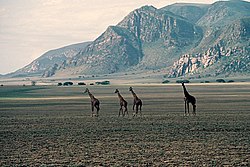
Malambo is a village in the Arusha Region of northern Tanzania, located near the Sanjan River, east of the Serengeti, west of Lake Natron, and north of Ngorongoro, in a picturesque but remote region. It is on the western edge of the Eastern Rift Valley, bordered by mountains on the west and a vast plain on the east.
Contents
Malambo has served as a home for many Maasai, and a rest stop for many more who pass through the region. It boasts a school, a medical clinic, a maternity clinic, and a small airstrip, though the village is still considered remote and impoverished. Because it is close to areas that are popular tourist safari attractions, visitors occasionally pass through.
In 2022-2023, Maasai people in the area raised concerns about forcible displacement by authorities seeking to limit settlement in the nearby Ngorongoro Conservation Area. [1] [2] [3]